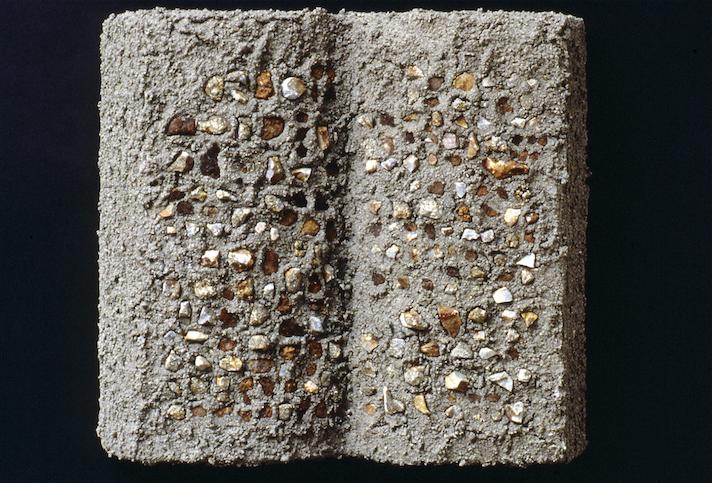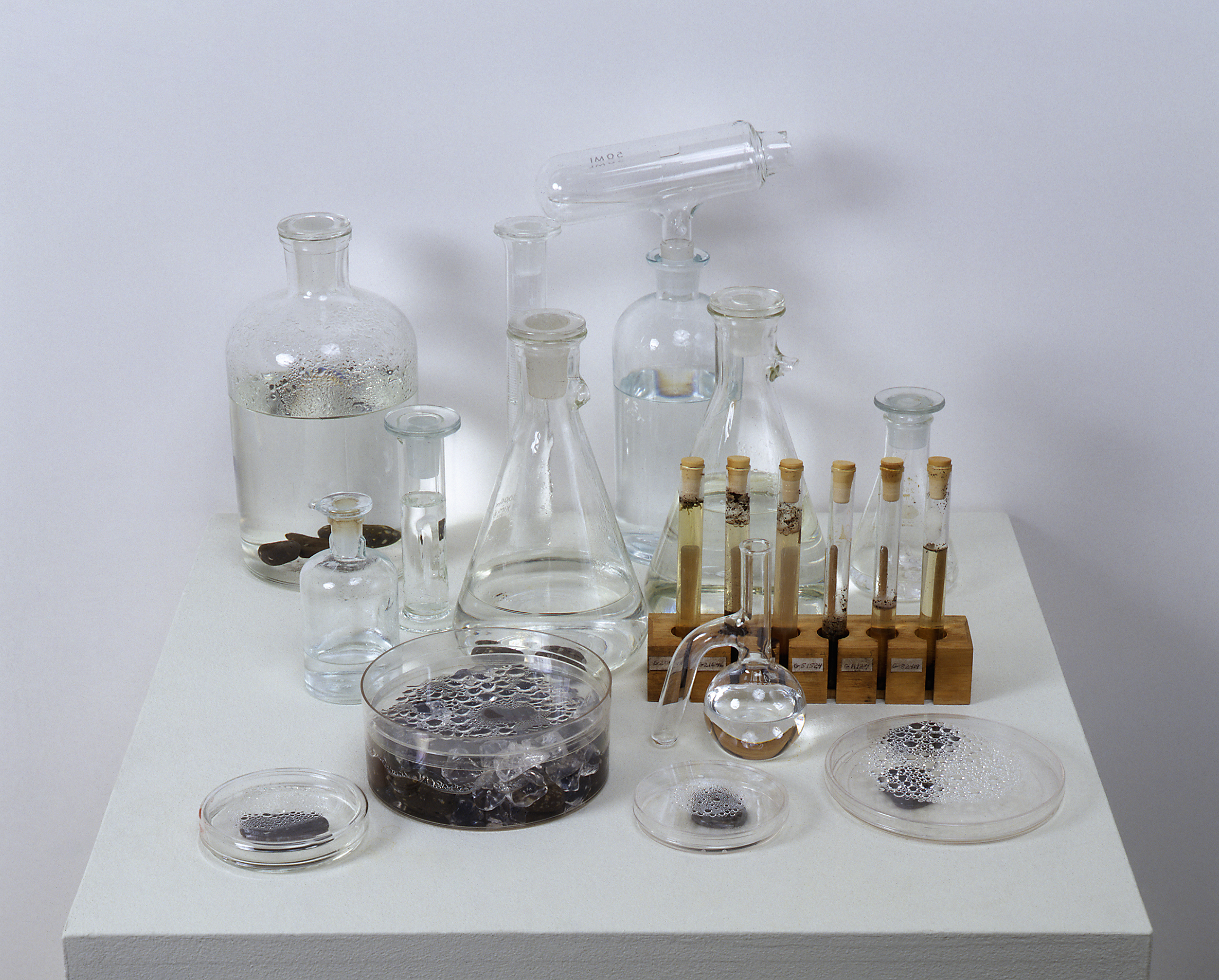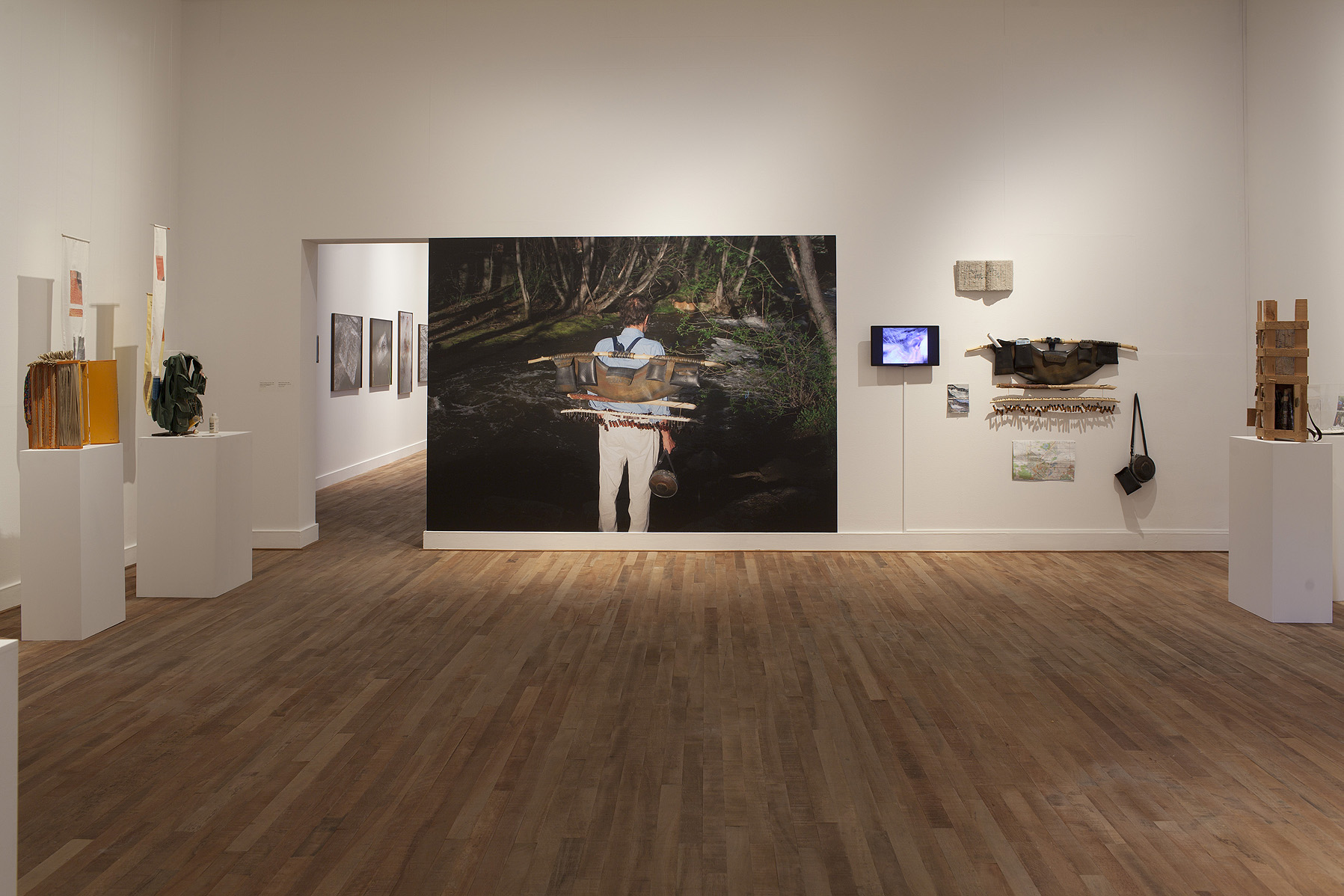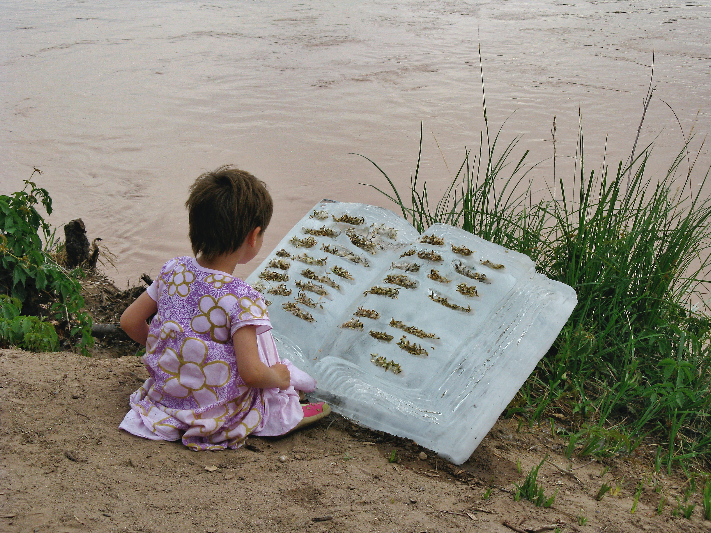
Molybdenum Mine Vol. 1, Hydrolibros
Flow and Integration in the River Basin: Basia Irland on her Career Inspired by and Alongside the Rivers of the World
Olivia Ann Carye Hallstein
Fulbright Scholar, Basia Irland, creates international water projects featured in two books, “Water Library” (University of New Mexico Press, 2007) and “Reading the River: The Ecological Activist Art of Basia Irland” (Museum De Domijnen, 2017). Through her work, Irland offers a creative understanding of water while examining how communities of all beings rely on this vital element. She is Professor Emerita, Department of Art and Art History, University of New Mexico, where she established the Arts and Ecology Program. Her art is featured in over 70 international publications.
Hello Basia, thank you so much for your time. It is such a pleasure to speak with you. Since your work has revolved around the major theme of rivers but has allowed for incredible depth and diversity in practice, I want to dig into several aspects of your career.

Hydrolibros series. Retrospective, Museum de Domijnen, The Netherlands
You have worked so closely with these soils, waters and riverbeds; often using close observation to determine and drive your artwork. Yet, many of these ecologies have experienced drastic change. Over the course of your career, climate-related disaster and water mismanagement has increased drastically. How has this affected your work? What have you noticed in the field?
Good question because these two areas affect my work every day. My global river projects have investigated climate disruption for decades. “Icefield” was created twenty-one years ago in 2000. When this installation, (in the collection of the Colorado Water Center), was reshown last year in 2020, at a Denver exhibition, the curator wrote: “Ice Field anticipated by many years the more recent alarm over glacial melting. Twenty years ago, when climate disruption was rarely discussed in most of the world, Irland spent time hiking on a number of glaciers, including those in Banff National Park, Alberta, Canada. Inspired by these hikes across glaciers and her observations of meltwater, Irland began thinking about a future when there would be no more glaciers on the planet and the runoff from the ice would be the only relic remaining for scientists to study. Knowing that meltwater contains microbial populations, nutrients and metals that escape from glaciers and feed downstream ecosystems, Irland developed an installation entitled Ice Field. She used some of the instruments of scientific research–petri dishes, vials, test tubes and flasks filled with water as both an artistic interpretation of a future scientific study set in a pristine lab and an ode to the melting glaciers themselves. Ice Field was also installed in 2015 as part of a major retrospective of Irland’s work at the Museum De Domijnen in the Netherlands.”
No matter how dire the situation for rivers seems to be these days, there are plenty of thoughtful humans along riverbanks everywhere who work tirelessly to envision a better future for their community waterways.
We have seen how pollution, dams, channelization, climate disruption, over-exploitation, habitat destruction, uncontrolled urbanization, floods, and drought are drastically affecting our waterways. However, it is also important to reflect on some of the positive ways local groups are actively addressing the problems. No matter how dire the situation for rivers seems to be these days, there are plenty of thoughtful humans along riverbanks everywhere who work tirelessly to envision a better future for their community waterways. Numerous restoration projects are happening thanks to local governmental, environmental, and health organizations. Residents and businesses, nearby schools, and universities all pitch in to assist. Globally, concerned people are stepping up to take care of degraded streams, but obviously there is continually more to be done.
 Icefield. Detail of installation.
Icefield. Detail of installation.
What a hopeful message! Your work has followed riverways all over the world. They are symbols of this global interconnectedness, yet each experience is individual. What are some similarities and differences that you have discovered in the stories the river ecologies have to tell? What do the rivers want us to know?
I have written twenty-four essays for National Geographic about international rivers, written in the first person, from the perspective of the water. Cultural critic Lucy Lippard writes, “The genius of these National Geographic posts is the fact that they are written in the first person, the persona of the river herself. This unorthodox viewpoint removes the distanced objectivity expected of journalistic criticism and delivers the writing into direct experience – not the experience of someone simply rafting and hiking and researching a river, but the experience of being a river.”
We are not separate from the waters of the world.
Almost all global rivers I have visited share similarities because they are in peril, but in different ways. The Bagmati River, Nepal is a dumping site for thousands of cremated bodies. The Narmada River, India, is sacred and yet has one of the largest dams in the world. Lake Tana is the source of the Blue Nile, Ethiopia, and is rampant with the water-borne disease, schistosomiasis. The Portneuf River is completely encased in concrete as it flows through Pocatello, Idaho, so it can no longer breathe and meander naturally.
On a brighter note, Singapore recycles almost all of its wastewater into clean drinking water using a rigorous treatment process. It was fascinating to visit one of their plants with a biologist and see the various technologies being utilized. I think rivers would want us to deeply understand that they are alive. They have a body called a watershed with a mouth at the delta; organs of wetlands and riparian zones; cells, molecules of water; and like us, a circulatory system. We are not separate from the waters of the world.
Your symbolism between humanity and waterways is deeply touching! And your work is very collaborative between disciplines and people. For example, you work closely with scientists and with large local communities. What have been some important moments related to these interdisciplinary and global collaborations?
I could not do the work I do without the collaboration of scientists from many disciplines, including parasitologists in Nepal; a restoration biologist with the Nisqually Tribe, Washington; an algal scientist in Georgia; a biogeochemist in Colorado. I have partnered with dozens of hydrologists, and when invited to create Ice Book projects, I work closely with stream ecologists and botanists to determine the best native riparian seeds. There were nine different departments and institutes at Antioch College and the University of Dayton, which invited me to create an Ice Book project in Ohio. This included the Rivers Institute and even the physics department.

Launching Book XXXI into Rio. Photo by Ben Daitz.
The Gathering of Waters, which establishes cooperative relationships between people, and connects diverse cultures along the entire length of rivers, emphasizes that we all live downstream, and how imperative it is that we work together to face water challenges. During the five-year long Gathering of Waters; Río Grande, Source to Sea, over a thousand people participated along the entire 1,875 mile-length of the Río Grande. A canteen and logbook traveled the route of the río by boat, raft, canoe, hot-air balloon, car, van, horseback, truck, bicycle, mail, and on foot -- always handed person to person the entire distance. Many of the nineteen Native American Pueblos in New Mexico along the Río Grande were involved by performing relays of running with the canteen from pueblo to pueblo escorted by Tribal Police cars. At each pueblo the arrival of the canteen would be greeted with a delicious home-cooked meal.
During the five-year long Gathering of Waters; Río Grande, Source to Sea, over a thousand people participated along the entire 1,875 mile-length of the Río Grande... Connections were made that have been lasting, and groups are working together that never would have met otherwise.
After five years, the project reached the Gulf of Mexico at Boca Chica where we held a grand ceremony with participants from Mexico and the United States, and the upper and lower basins celebrating together. Connections were made that have been lasting, and groups are working together that never would have met otherwise.
The sculptures accompanying these projects are Backpack/Repositories constructed from local materials, which contain artifacts and research from the Gatherings. They hold the scientific data, canteens, logbooks, maps, water samples, photographs, video documentaries, and other relevant art objects and information. Through an encompassing ethic of inclusion, we witness the diversity of life along the river being celebrated again and again as the container passes downstream, hand to hand. Lucy Lippard, writes; “A Gathering of Waters is a major model for eco-art. Irland takes the journey herself, swimming upstream against the currents of a society not yet convinced that our comforts are worth sacrificing for our resources.” As with the Ice Book projects, each participant is presented with a handmade gift, often sculpted from river clay, to express appreciation for their help. Reciprocity.”

Saskatchewan River Delta Backpack-Repository. Canada
To participate in both of the Gathering and Ice Receding/Books Reseeding Projects, you have to physically be at the river and interact with others. Being aware of the plight of flowing water that is always asked to give more than it has, is a call for action from each of us.
In addition to the Río Grande, Gatherings have occurred along numerous other rivers. To participate in both of the Gathering and Ice Receding/Books Reseeding Projects, you have to physically be at the river and interact with others. Being aware of the plight of flowing water that is always asked to give more than it has, is a call for action from each of us. In the video documentary about the Gatherings, my son, Derek, stands in the middle of the Río Grande on a small sandbar and tweaks a famous quote; ‘Ask not what this river can do for you, but what you can do for this river.’

Boulder Creek Repository (worn), Colorado (center). Retrospective, Museum de Domijnen, The Netherlands.
Just last week I received an email inquiry about the Gathering Projects from an ecologist in the UK who wrote, “In particular, I am in love with your log-book idea in A Gathering of Waters: The Río Grande, Source to Sea – how it meanders down-stream from person to person, community to community. I am considering how I might adapt that as a means to connect people in a similar way and be a participatory method to create knowledge to inform my research into how people feel – relational and intrinsic values, and wellbeing - about their temporary chalk streams in southern England.”
You mentioned your ice books. And I wanted to ask you specifically about, Ice Receding/Books Reseeding, how they function as seeding depositories supporting biodiversity along river ecologies and bring awareness to melting glaciers. What is your process in deciding what seeds to include in which spaces?
The Ice Book projects emphasize the necessity of communal effort, scientific knowledge, and artistic expression to address complex environmental issues and watershed restoration by releasing seed-laden ephemeral ice sculptures into rivers.
The idea for the Ice Books began in 2007 when I was invited to do a project along Boulder Creek in Colorado as part of an exhibition focused on the climate crisis. Each of the artists was paired with a local scientist. I have often collaborated with scientists from a variety of disciplines throughout my career, and it was wonderful to work with a biogeochemist on this project. A primary water source for Boulder is Arapaho Glacier, and that glacier, as with most others in the world, is melting so drastically that it may soon disappear entirely. Creating a sculpture out of ice makes this idea visible, so we tangibly sense the loss of glaciers. Simultaneously, positive action is promoted by implanting seeds within the ice. The seeds present both a practical and poetic possibility for repair and renewal.
Creating a sculpture out of ice makes this idea visible, so we tangibly sense the loss of glaciers. Simultaneously, positive action is promoted by implanting seeds within the ice. The seeds present both a practical and poetic possibility for repair and renewal.
The seeds embedded in the ice form a universal ecological language, a restoration text, a poem to the river. I work closely with stream ecologists and botanists to ascertain the best native seeds for each riparian zone. Sometimes other natural materials are used instead of seeds. Deckers Creek in West Virginia is highly polluted with acid mine drainage. At this location the pH level drops from a healthy 7.7 to a problematic 4.2. Instead of seeds, we used limestone because of its ability to neutralize acidity. On False Creek in Vancouver, Canada, krill was used rather than seeds to provide food for small fish with the hope of luring salmon back into the area.
Most of these projects are highly collaborative and could not occur without the effort of many people working together along rivers where I am honored to be invited. With the help of local communities, the Ice Books are launched into the water. The calligraphic sentences of seeds slide from the melting pages of the volumes into the water to be carried to shore and begin planting themselves along the banks of the river.
In the years since the first Ice Book project, I have been invited to create over one-hundred hand-carved time-based sculptures to bring attention to rivers and how we might help with restoration efforts. These projects are not about abstract theorizing while sitting indoors; rather, they are about connecting diverse, multi-generational communities directly to their local waterways and taking tangible action for river repair. The Ice Books are replicable, ephemeral, use non-toxic materials, leave behind only native plants, and present a lyrical way to restore streams.

Tome II being read beside the Río Grande, New Mexico. Photo by Claire Cote.
These projects are not about abstract theorizing while sitting indoors; rather, they are about connecting diverse, multi-generational communities directly to their local waterways and taking tangible action for river repair.
Recently I have been working with people from around the world who want to create their own Ice Books to make connections to their waterways and initiate restorative actions that address local ecological issues. The results have been inventive, educational, and inspiring, with examples coming in from Spain, France, the Netherlands, Canada, Ireland, and many parts of the United States, including Hawaii.
A professor in China organized a two-day workshop with adults and children who launched Ice Books into the confluence of the Jailing and Yangtze Rivers. An Ice Book in England focuses on species loss and the collapse of amphibian populations. A frozen volume in Sydney, Australia is embedded with mangrove seedlings. An indigenous artist in the U.S. carved the words for “Water is Life” in his native tribal language and placed sacred corn within the text. The book was planted in the red desert earth of the Navajo Nation. Dutch Ice Books witness a river that has been dredged to help alleviate flooding. Imbedded in an Ice Book from Mexico are plants important to the ancient Lake Xochimilco and the historic canals of Mexico City. If you visit your local river today, what would you add to an Ice Book to bring attention to ecological issues faced by your watershed?
What a fantastic call to action! Your related work, Hydrolibros, accentuates local ecologies through bound books using materials from the riverbeds you explore. Through these materials you tell stories. What is your approach to telling these stories through materials?
One example of the numerous stories told in a Hydrolibros sculpture is Molybedenum Mine, Vol. I that commemorates a huge scar gaping across acres of abused wilderness in northern New Mexico caused by the Chevron Questa molybedenum mine (formerly the Molycorp Mine). Wandering illegally among the heaps of discarded mining equipment, I found the text for this hand-carved wooden book, which was fool’s gold and rust – poetic justice for this site, the tailings of which historically killed aquatic habitat for over ten miles downstream in the Red River and contaminated the soil. The mine began operations in 1920 and was officially closed in 2014. An image of Molybdenum Mine, Vol. I was included in the 2020 book, Extraction, Art on the Edge of the Abyss (pp. 480-48, CODEX Foundation).
Speaking of literature, in your scrolls you explore waterborne diseases and present them in beautiful ways and yet they are deadly…
Yes, I am very interested in the notion of a terrible beauty. When isolated and viewed through a microscope, the pathogens look incredibly beautiful, and yet, the tragic reality is that waterborne diseases kill millions of people around the world every year. According to the World Health Organization, a child dies from a water-related disease every eight seconds. A BBC reporter phrased it this way: “The number of deaths due to water pathogens is the same as twenty jumbo jets crashing each day.” The dark, destructive side of water is as fascinating and rich in history as its more sanguine side. Many households around the world, including here in the United States, do not have clean water, and this must be considered one of the most serious public health crises facing us.
For more extensive writings on The Terrible Beauty of Waterborne Micro-Pathogens, see chapter six “Polluted Waters” in Water Library, Basia Irland, University of New Mexico Press, 2007.

Waterborne Disease Scrolls. Retrospective. Museum de Domijnen, The Netherlands.
As well as your awareness work, you have created spaces for people to contemplate the river in meditation with it. You describe your Contemplation Stations as places to “repose by yourself and view a flowing stream that has the ability to quiet the mind, relax the body and feed the soul.” What was your inspiration for this work and how has the need for this developed during the past few years?
In our overly frenetic, busy lives, I enjoy creating spaces where one can visit and experience a sense of tranquility and peace – away from the work-a-day world. Contemplation Stations are woven river plants constructed around a sturdy outdoor wooden chair placed on a site near the river so the viewer can be cocooned within and be quietly attentive. The overhead dome-shape frames the view so a person's perception is focused intently on the river. All the senses are heightened when in this type of setting. The smell of nearby plants, the sight of the current flowing downstream, the call of birds, are all brought into perspective and can be more deeply appreciated.
All the senses are heightened when in this type of setting. The smell of nearby plants, the sight of the current flowing downstream, the call of birds, are all brought into perspective and can be more deeply appreciated.
I created seven of these sculptural forms on the River Maas, which is the border between Belgium and the Netherlands when I had a large retrospective at the Museum de Domijnen, the Netherlands. Recently, I built and located three of the Stations along the Río Grande in New Mexico as a way for people to contemplate and focus on the importance of this major artery of the Southwest. During this time of Covid, I have heard from many people who seek out the (“socially distanced” -- ha) Stations as a site to be alone in a quiet, beautiful setting.
So, the viewer is integrated into the flow and tide of the river itself? Much of your work involves ephemeral pieces that reintegrate with the chosen ecology as if in keeping with the flowing natural cycles of life. What has drawn you toward the ephemeral as a process?
Translator, David Hinton describes ancient Chinese poets who, as a form of spiritual practice, would write on rocks and trees with water-soluble ink that would wash away in the rain, so the poem was complete only when it vanished. Just as the prayer flags I photographed strung near sacred sites and hanging from temple trees throughout Nepal and India transport blessings on the wind, the rivers of the world need all the reverence and protection we can provide.
In my art, the process of creation is as important as the sculptures, which in the case of the Ice Books (described previously), are impermanent, only existing after the event through documentation and plants. Part of the significance of these time-based sculptures is that they melt away. Time and energy, which have gone into the carving of the Books vanish in the current of a stream. Everything we know is in existence for only a period of time. Instead of dust to dust, here we have water to water. A marble or steel sculpture will also eventually, over millennia, go back into the earth, but the process is speeded up drastically in melting ice. Ways of knowing later about an ephemeral object or event is through documentation. I utilize writing, filming, photography, and drawing, which are shown in museum installations.
Instead of dust to dust, here we have water to water. A marble or steel sculpture will also eventually, over millennia, go back into the earth, but the process is speeded up drastically in melting ice.
Lastly, you recently had a retrospective of your life’s work thus far. How does it feel to see it all come together? And what are you planning to do next?
I was invited by the amazing Dutch curator Roel Arkensteijn to have a large retrospective at the Museum de Dominjnen in the Netherlands, which was the most wondrous experience! The museum hired eight preparators who helped with anything that I wished to create, including installing a long reflecting pool of water with stepping-stones within the museum. My work took up seven enormous galleries and filled the entire museum. We even projected images of flowing water, entitled Below, onto the façade windows to indicate that this building might someday be underwater since the Netherlands lies so low.
It was fantastic to see older work side by side with brand new work created specifically for the space. We constructed seven Contemplation Stations (discussed previously) out of natural local materials that were sited along the River Maas. Within the museum was a location map of these Stations.
I feel totally fortunate to wake up each day and do the work I love to do!
The primary focus right now is representing the United States in the upcoming Biennale, Cuenca, Ecuador, curated by the brilliant Blanca de la Torre. All the work I am creating for the museum is being produced on site (instead of shipping art) to keep our ecological footprint to a minimum, including video installations translated into Spanish and projects focused on the four major regional rivers. I am also creating collaborative aquatic projects with an artist in Xochimilco, Mexico and a scientist in the UK. I feel totally fortunate to wake up each day and do the work I love to do!!
Thank you so much for your time, Basia! What amazing messages and inspiration our readers can take from your experience!
To see more of Irland's work go to basiairland.com

Contemplation Station VII before being moved to the River Maas.